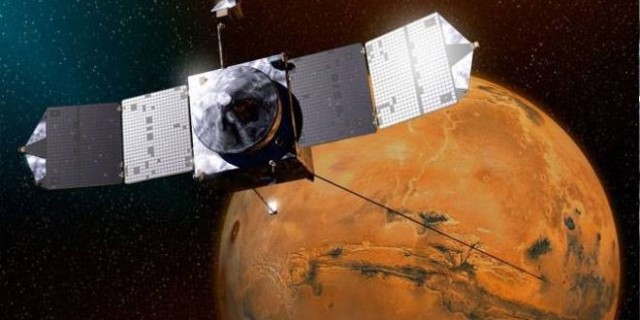NASA tests rocket engine intended to take humans to Mars
TWELVE million horsepower — what a ride. This is the engine that may take us to Mars, and it’s just been fired up for the first time at a NASA testing facility.
The RS-25 engine was fired up at the Stennis Space Centre in Mississippi. It burned for nine minutes, chewing through nine swimming pools worth of fuel.
“It is the most complicated rocket engine out there on the market, but that’s because it’s the Ferrari of rocket engines,” NASA propulsion engineer Kathryn Crowe said.
Under pressure
The engine represents a significant boost in power and efficiency over past rockets — even though its design dates back to the 1970s.
NASA needs it if it is serious about returning to manned space flight. It lost that capability with the final flight of the Space Shuttle in 2011.
And orbit is just the first step: Going further is much harder.
“Orbital velocity, just for starters, is over 17,000mph (27359km/h), and that only gets you a couple hundred miles off the surface,” says SLS spokesman Martin Burkey. “Going farther requires going faster. Much faster.”
To this end the Space Shuttle Program vintage rocket had its thrust output improved, weight reduced and fuel efficiency optimised.
At the moment one of these engines weighs roughly double that of a modern fighter jet’s, but it produces eight times more thrust. That means 232,000kg of pressure.
“That’s enough to push 10 giant aircraft carriers around the ocean at nearly 25mph (40km/h),” Mr Burkey says.
In practical terms, that means it can lift a 70 metric ton payload out of orbit.
Stress tests
The engine has so far completed six out of seven scheduled live-fire tests.
It must prove to be capable of withstanding temperatures as low as -240C, where the fuel enters the engine, and as high as 3300C in the exhausts when under ‘full burn’.
Then there are the stresses and pressures of great speed.
“At such high speeds, even the smallest hitch in the process can cause massive problems, which is why the engines need to be tested extensively in a controlled situation before even thinking about leaving the ground,” Mr Burkey said.
The next big test is strapping four of the RS-25 engines together for a full simulated launch.
When attached to its two solid fuelled boosters and fuel tank, the completed rocket is called the Space Launch System (SLS).
It’s hoped that it will eventually boost Orion manned space capsules out of Earth’s orbit, and perhaps even to Mars.
